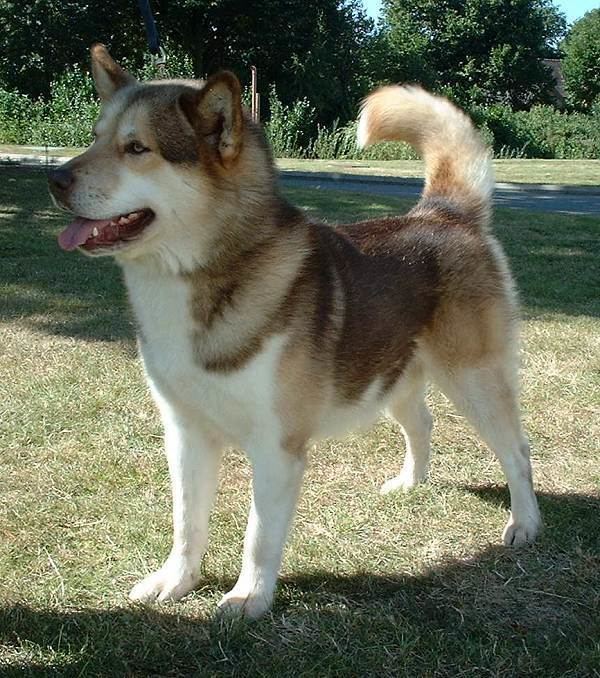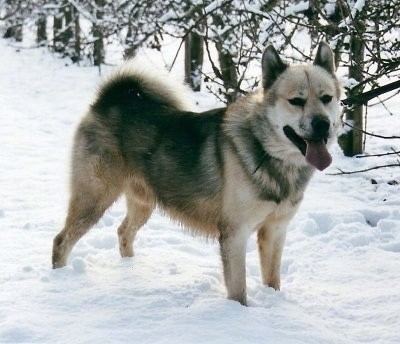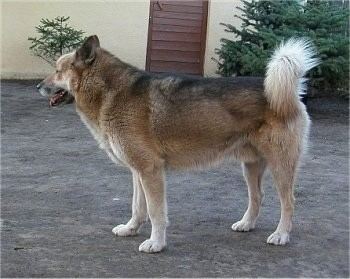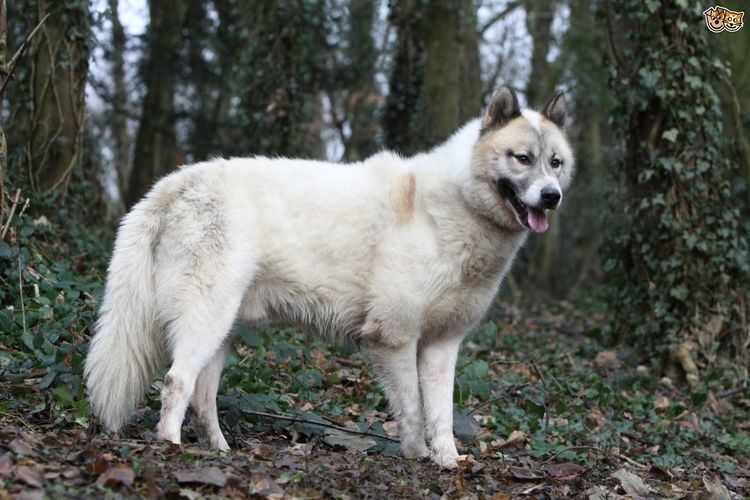CKC Group 3 - Working Dogs KC (UK) Working Scientific name Canis lupus familiaris | Group 3 - Working Dogs standard Working standard | |
 | ||
Other names Kalaallit qimmiat (Qimmeq)GrønlandshundGrünlandshundEsquimaux DogCanis lupus familiaris borealis FCI Group 5, Section 1 Nordic Sledge Dogs #274 Temperament Bold, Boisterous, Loyal, Energetic, Friendly, Independent Weight Female: 30–32 kg, Male: 30–32 kg Height Female: 51–61 cm, Male: 58–68 cm Colors Black, White, Grey, Spotted White Similar Norwegian Buhund, Canaan Dog, Icelandic Sheepdog, Eurasier, Swedish Lapphund | ||
Greenland dog dog breed
The Greenland Dog (Greenlandic: Kalaallit Qimmiat, Danish: Grønlandshunden) is a large breed of husky-type dog kept as a sled dog and for hunting polar bear and seal. They were brought from Siberia to North America by the Thule people 1,000 years ago, along with the Canadian Eskimo Dog that is genetically identical.
Contents

Lineage

The first dogs arrived in the Americas 12, 000 years ago, however people and their dogs did not settle in the Arctic until the Paleo-Eskimo people 4,500 years ago and then the Thule people 1,000 years ago, both originating from Siberia. Dogs first appeared in Greenland around 4,000 years ago. The Inuit dogs from Canada (Canadian Eskimo Dog) and Greenland (Greenland Dog) descended from dogs associated with Thule people, who relied on them for transportation from Siberia. In 2015, a study using a number of genetic markers indicated that these were both the same dog and should not be treated as separate breeds, that they maintain an indigenous heritage that predates colonization and the timing corresponds with the arrival of the Thule people, and that they were distinct from Siberian Huskies, Alaskan Huskies and Malamutes. The maternal mitochondrial DNA sequences of the Inuit dogs were classified as haplotype A31 that indicates a common female ancestor, and this haplotype could not be found in other modern dogs but the nearest match was with a 1,000 year–old dog from Florida.

In 1975, a study was made of ancient canid remains dated to the Late Pleistocene and early Holocene that had been uncovered by miners decades earlier around Fairbanks, Alaska. These were identified as Canis lupus and described as "short-faced wolves". The collection was separated into those specimens that looked more wolf-like (i.e. the Beringian wolf), and those that looked more dog-like and in comparison to the skulls of Eskimo dogs from both Greenland and Siberia thought to be their forerunners.

Nearly all dog breed's genetic closeness to the gray wolf is due to admixture. However, several Arctic dog breeds show a genetic closeness with the now-extinct Taymyr wolf of North Asia due to admixture. These breeds are associated with high latitudes - the Siberian husky and Greenland dog that are also associated with arctic human populations, and to a lesser extent the Shar Pei and Finnish spitz. An admixture graph of the Greenland dog indicates a best-fit of 3.5% shared material, however an ancestry proportion ranging between 1.4% and 27.3% is consistent with the data. This indicates admixture between the Taymyr wolf population and the ancestral dog population of these 4 high-latitude breeds. This introgression could have provided early dogs living in high latitudes with phenotypic variation beneficial for adaption to a new and challenging environment. It also indicates the ancestry of present-day dog breeds descends from more than one region.
Appearance

The Greenland Dog is a powerful, heavy-built dog. It has a broad, wedge-shaped head, slightly tilted eyes and small, triangular ears covered with thick fur that prevents frostbite. It has strong, muscular, short-haired legs. The tail is usually rolled along/across its back. When it lies down and curls up to rest, the tail often covers the nose. Its coat is of medium length and consists of two layers. The inner layer consists of short wool-like fur, the outer layer of longer, coarser, water-repellent fur.
A characteristic of most Greenland Dogs is the "úlo", a triangular shaped area on the shoulders. It is named after a common woman’s-knife from Greenland which is of the same shape.
Males are significantly larger than females at between 58 and 68 cm (23–27 in) at the withers; females are between 51 and 61 cm (20–24 in).
Temperament
In Greenland this breed exists in much the same condition as it had when originally arriving there, and is kept chiefly as a working dog valued for its strength and speed rather than a malleable temperament. As a result of living in a pack structure, the Greenland dog takes a very firm and confident owner to make a good pet. Once one has won their respect, however, they can be very loyal and protective of their owners, especially if in a pack.
Stamina
As is common among sled dogs, Greenland Dogs are able to traverse very difficult terrain with ease and with a high tempo. As working dogs they are especially valued for their physical strength and endurance.
History
The Vikings were the first Europeans to settle in Greenland and subsequently became aware of these dogs. Then others like the early European whalers, explorers and fur traders in Canada and North America trained dog-sledding skills from the natives of the Arctic region, and used with great success the Greenland dog when hunting, exploring and traveling across the Arctic regions.
It is thought that the first dogs were brought to Britain around 1750; an Esquimaux bitch was exhibited at one of the earliest dog shows held in Darlington on 29 July 1875, which was reported in the Live Stock Journal and Fanciers Gazette published on the 6th of August 1875. They were recognized by the Kennel Club at its foundation in 1880. Greenland dogs are classified as Spitz breeds, a group of dogs characterized by their prick ears, curly tails and thick coats and are among the oldest known dog breeds in the world today.
The Greenland dog has been a draught animal in the Arctic regions for centuries and consequently they have developed a powerful body and heavy coats, with a natural capacity for load pulling and endurance in a harsh working environment. Greenland dogs have been used on many expeditions by explorers, the most famous being Fridtjof Nansen. Nansen recorded in his book På ski over Grønland, Greenland dogs being used as working dogs by the Greenland Native. Nansen was a successful polar explorer and used the dogs on his famous voyage across the Arctic Ocean in the equally famous ship Fram. Roald Amundsen used the Greenland Dogs as well on his expedition to the Antarctic. Amundsen carefully chose 97 Greenland dogs to accompany him and his team on his expedition to Antarctica and in his subsequent South Pole expedition. Both men started with more dogs than they technically needed to pull as sledge, intending to feed the weakest dogs to the strong ones during the voyage.
